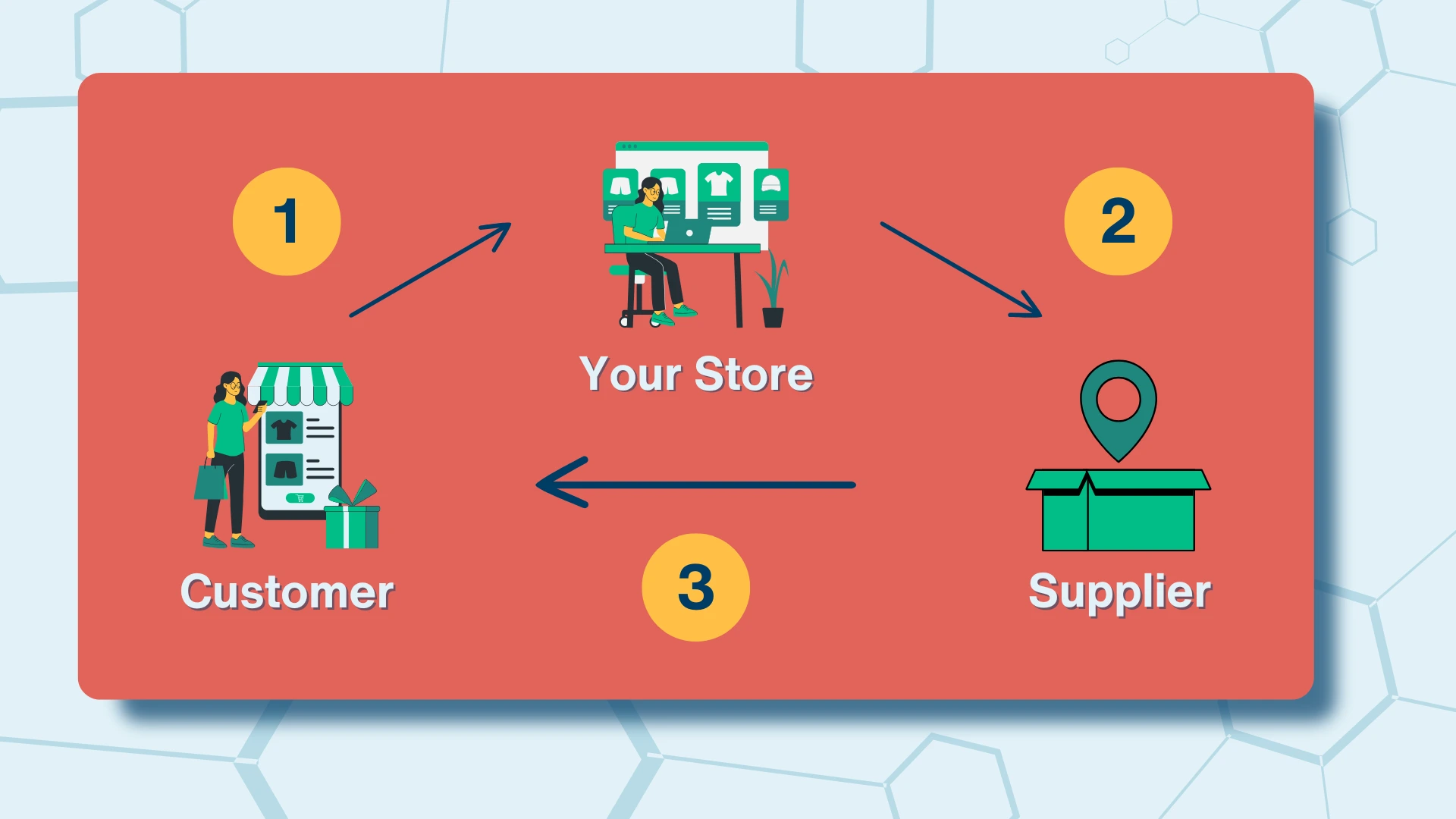Selling on Amazon can be incredibly lucrative and rewarding, but managing inventory can be a logistical nightmare and a financial burden. However, you can bypass these challenges entirely when you know how to sell on Amazon without inventory.
Amazon’s Fulfillment by Amazon (FBA) program makes it easier than ever for people to run and operate online businesses. Still, the program comes with numerous fees and costs that cut deeply into profits, begging the question, “Can you sell on Amazon without inventory?” Fortunately, you can avoid these challenges altogether by adopting strategies enabling you to sell on Amazon without holding any inventory.
Whether you’re just starting out or looking to streamline your business, there are strategies for running a profitable Amazon business without the hassle of inventory management.
Selling on Amazon without holding inventory offers a few game-changing advantages:
- Lower Overhead Costs: By not purchasing and storing inventory, you eliminate significant upfront expenses and ongoing storage fees. This allows for a leaner business model that is easier to scale.
- Reduced Risk: Inventory-free selling minimizes the financial risk associated with unsold stock, especially in industries with rapidly changing trends.
- Easier Scalability: You can expand your product offerings without worrying about logistics, storage space, or supply chain complexities, making it simpler to grow your business.
Sound too good to be true? While we can assure you it’s as good of an opportunity as it sounds, it’s not far-fetched. Thousands upon thousands of sellers have taken this path to profits on Amazon.
In this article, we’ll explore five methods for selling on Amazon without inventory, helping you choose the best approach to build a successful, hassle-free business.
Dropshipping on Amazon
What Is Dropshipping?
Dropshipping is a business model that allows you to sell products directly to consumers without ever handling the inventory. When a customer places an order, you purchase the item from a third-party supplier, who then ships it directly to the customer. The main advantages of dropshipping include low startup costs, minimal risk, and the ability to offer a wide range of products without the need for storage space.

However, Amazon dropshipping isn’t without its challenges. The lack of control over inventory and shipping processes can lead to delays or stockouts, potentially harming customer satisfaction and seller ratings.
Pros:
- Low startup costs
- No need for storage space
- Ability to offer a wide range of products
Cons:
- Limited control over the supply chain
- Potential for lower customer satisfaction due to shipping delays
How It Works With Amazon
Amazon’s platform is well-suited for dropshipping, thanks to its integration with automated tools that streamline order fulfillment. By leveraging these tools, you can ensure that orders are processed swiftly and accurately, with minimal intervention. But, keep in mind that Amazon has strict policies regarding how to dropship without inventory, such as being the seller of record and ensuring that your business name is on all invoices and packaging slips.
How to Setup Dropshipping
Setting up a dropshipping business on Amazon involves several key steps:
- Create a Seller Account: First, sign up for an Amazon Seller account. You can choose between an Individual or Professional account based on your expected sales volume.
- Find Reliable Suppliers: Use tools like Oberlo or AliExpress to identify suppliers with high ratings and reliable shipping times. Building solid relationships with suppliers is crucial to ensure product availability and prompt fulfillment.
- Automate Order Fulfillment: Leverage software like integrating Shopify with Amazon to automate order processing and inventory management. This will help you manage multiple suppliers efficiently and reduce manual errors. You could even opt to join FBA and sell Amazon FBA without inventory if you wanted to streamline the entire process from ordering to customer service.
- Stay Compliant: Familiarize yourself with Amazon’s dropshipping policies to ensure your business operates within the platform’s guidelines. This includes being the seller of record and ensuring that your invoices and packaging reflect your business name.
Pro Tip: Regularly audit your supplier relationships and fulfillment processes to maintain high customer satisfaction and compliance with Amazon’s policies.
Use Amazon FBA for Retail Arbitrage
We’ll be the first to admit that Amazon retail arbitrage technically includes storing inventory. However, it’s an untraditional method of storing Amazon seller inventory with significantly lower costs and relatively low effort, we’ll slide retail arbitrage as a way to start an Amazon store without inventory.
Retail arbitrage involves buying discounted products from retail stores or online outlets and reselling them on Amazon at a higher price. When combined with the FBA service, you can offload the storage and shipping duties to Amazon, making this an inventory-free strategy.
Pros:
- Potential for high-profit margins
- Amazon handles fulfillment, including storage and shipping
- More straightforward to scale compared to traditional retail models
Cons:
- Competition can be intense, especially for popular products
- Requires upfront investment in inventory
How To Get Started With Retail Arbitrage
- Source Discounted Products: Visit clearance sections of local stores, check out Goodwills in your area, or use online platforms like eBay or Walmart to find discounted items. Tools like our Market Intelligence and Competitor Intelligence can help you track Amazon’s price history and identify potential arbitrage opportunities.
- Prepare and Send to Amazon FBA: Once you’ve sourced your products, label and package them according to Amazon’s FBA guidelines. You can send the products directly to Amazon’s fulfillment centers or consider using a prep service to handle labeling and shipping on your behalf.
- Monitor Your Listings: Use Amazon’s Seller Central to monitor your listings, track inventory, and adjust prices as necessary to stay competitive.
Pro Tip: Keep an eye on Amazon’s own inventory of the products you’re selling. If Amazon starts selling the same item, it might be time to shift your focus to a different product to maintain your profit margins.
Amazon Merch on Demand
Amazon Merch on Demand, previously known as Merch by Amazon, is a print-on-demand (POD) service that allows sellers to create and sell custom-designed products like t-shirts, mugs, and other items directly on Amazon. This platform is an excellent option for creatives and entrepreneurs looking to monetize their designs without upfront investments in inventory or manufacturing. Once a design is uploaded to Merch on Demand, Amazon handles the rest—from printing the product to shipping it directly to customers, all while listing the items on the Amazon marketplace.
This integration with Amazon’s vast marketplace means that your custom products are instantly available to millions of potential customers, benefiting from Amazon’s powerful distribution and logistics network. Sellers can customize products endlessly, allowing them to easily cater to specific niches and trends. However, while the platform offers significant advantages, it also comes with certain trade-offs that sellers should consider.
Pros and Cons of Amazon Merch on Demand
Pros:
- No Inventory Management: Amazon handles production and fulfillment.
- Unlimited Product Customization: Sellers can create endless custom designs at no extra cost.
- Direct Shipping to Customers: Amazon manages shipping, ensuring timely delivery.
Cons:
- Lower Profit Margins: Print-on-demand services typically offer lower profit margins compared to bulk manufacturing.
- Quality Dependence: Product quality depends on Amazon’s printing and fulfillment processes.
- Limited Branding: Customization options for branding are limited compared to selling on your own platform.
Amazon Merch on Demand offers a low-risk, high-potential avenue for selling custom products online. Still, success requires careful consideration of the trade-offs and strategic use of the platform’s features.
How To Start an Amazon Merch on Demand Business
- Create an Amazon Merch Account: Sign up for an account and apply for Merch by Amazon. Once approved, you can start uploading your designs.
- Design Products That Sell: Focus on niche markets or trending topics to create designs that resonate with specific audiences. Tools like Adobe Illustrator or Canva can help you create professional-quality designs.
- Optimize Your Listings: Use relevant keywords in your product titles and descriptions to improve search visibility on Amazon. Ensure your designs are visually appealing and cater to current trends.
For questions about Amazon Merch on Demand, from intellectual property to percentage cuts, we recommend checking out their FAQs for guidance on hot Merch on Demand topics.
Pro Tip: Monitor your sales data regularly to identify which designs perform well. Luckily, since the items are printed on demand, it limits the risks of creating designs that fail to reach or resonate with shoppers. However, if you find a popular niche, you can hone in on the topic or style to double down on your success without assuming much risk.
Affiliate Marketing With Amazon Associates

Affiliate marketing employs various strategies to drive sales and boost brand visibility. Even major publishing companies like GQ and Tech Radar have embraced this approach, supplementing their revenue with passive earnings via affiliate marketing.
Content marketing is a popular strategy, where you create useful content like product reviews and tutorials to earn customer trust and encourage purchases through your affiliate links. Another practical approach is paid ads, such as pay-per-click (PPC) advertising, where you pay each time someone clicks on your ad. Social media marketing also helps promote your products directly through posts that engage your audience.
Pros:
- No Inventory/Logistical Concerns: You don’t handle the products; Amazon does.
- Potential to Earn from Diverse Product Categories: You can promote products across multiple categories.
Cons:
- Earnings Depend on Traffic and Conversions: Success is directly tied to your ability to drive traffic to Amazon.
- Changes in Commission Structure: Amazon periodically changes its commission rates, which can impact your earnings.
Effective Affiliate Marketing
While there are numerous ways to profit through affiliate marketing, successful efforts generally all follow these three steps:
- Create Engaging Content: Develop blogs, videos, or social media posts that showcase products.
- Drive Traffic: Use SEO techniques, social media marketing, and email campaigns to drive traffic to your affiliate links on Amazon.
- Optimize Conversions: Focus on high-traffic niches and seasonal products to maximize earnings.
Pro Tip: Use a combination of a Google SEO tool like Ahrefs or Semrush, along with Viral Launch’s Keyword Research and Keyword Manager to identify highly-searched keywords that can drive traffic to your affiliate content and monitor traffic and conversion performance for those keywords.
Sell Digital Products With Amazon Kindle Direct Publishing

Another golden opportunity to make money on Amazon without inventory is knowing how to sell non-physical products on Amazon. If you have a knack for writing, Amazon Kindle Direct Publishing (KDP) allows you to sell ebooks without inventory. Digital products like ebooks have high profitd margins and require no physical storage.
Pros:
- High Royalties: Authors can earn up to 70% on sales.
- Complete Creative Control: Authors retain full rights to their content and can control every aspect of their book’s design and pricing.
- Quick Publishing: KDP allows you to publish and start selling your book within days.
Cons:
- DIY Book Design: You may need to hire editing and cover design professionals to ensure your book meets industry standards.
- High Competition: The low entry barrier means thousands of new titles are published daily.
- Marketing and Promotion: Authors are responsible for marketing their books, which requires time and effort.
Furthermore, KDP’s DIY nature means that authors must handle all aspects of book design and editing themselves or hire professionals to ensure their book meets industry standards.
Despite these challenges, the quick publication process and the ability to retain a high level of creative control make KDP an attractive option for both new and experienced authors looking to publish their work globally.
Quick Tips for Selling on Amazon
If you’re new to selling on Amazon or branching out by selling without inventory, here are a few tips and considerations to help you start strong in the marketplace.
- Understand Amazon’s Policies: Familiarize yourself with Amazon’s guidelines, including their terms of service, seller policies, and any specific rules related to the selling method you choose (e.g., dropshipping, FBA, etc.). Staying compliant will help you avoid account suspensions and penalties.
- Leverage Amazon Tools: Amazon offers various tools to optimize your selling experience. Tools within Amazon Seller Central paired with the Viral Launch software suite and an FBA Calculator to manage your business more efficiently and effectively, from pricing to marketing.
- Optimize Product Listings: Invest time crafting compelling product titles, bullet points, and descriptions. Use high-quality images and include relevant keywords to improve your product’s visibility in Amazon’s search results. Well-optimized listings can significantly boost your sales, increasing visibility and conversions at every stage of the selling process.
- Stay Updated on Trends: Amazon is a dynamic marketplace with evolving trends. Join Amazon seller forums or subscribe to industry blogs (ahem, like this one) to stay informed about new tools, updates to Amazon’s policies, and shifts in consumer behavior.
- Prepare for Seasonality: Sales on Amazon can fluctuate with seasons and holidays. Plan by stocking up on trending products, optimizing your listings, and ramping up marketing efforts during peak times to capitalize on increased traffic.
While mastering Amazon would require an almost endless list of tips for every category and selling method, remembering these guidelines and executing aspects of your business with these practices in mind will put you on the fast track to success. For a more in-depth guides on how to sell on Amazon, check out our free resources listed below to follow proven methods for success.
- How to Sell on Amazon (Free Course)
- How to sell on Amazon (Free Ebook)
- How to Sell on Amazon Checklist (Free Ebook)
- How to Sell on Amazon (Step-by-Step Blog article)
Final Thoughts on Selling on Amazon Without Inventory
Selling on Amazon without inventory isn’t for everyone, but it presents a compelling opportunity for many. Whether you choose dropshipping, FBA arbitrage, print-on-demand, affiliate marketing, or digital products, each method offers unique advantages to help you achieve your business goals.
Now that you understand how to sell on Amazon without inventory, take the time to research these methods thoroughly, considering your resources, goals, and market trends. By selecting the right approach and mastering how to become an Amazon seller without inventory, you can build a successful online business while sidestepping the challenges of traditional inventory management.
Once you’ve determined the method that fits your goals and resources, the only thing left to do is execute your strategy and join the hundreds of thousands making money through Amazon!








